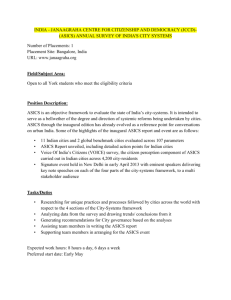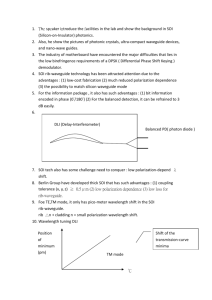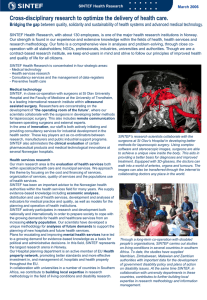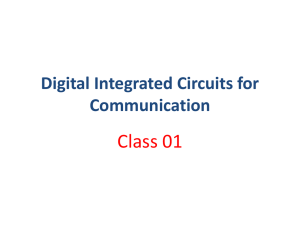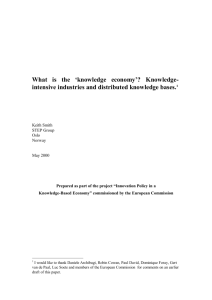HTelectronics_IRTG_Bergen_Oct2012_v3
advertisement
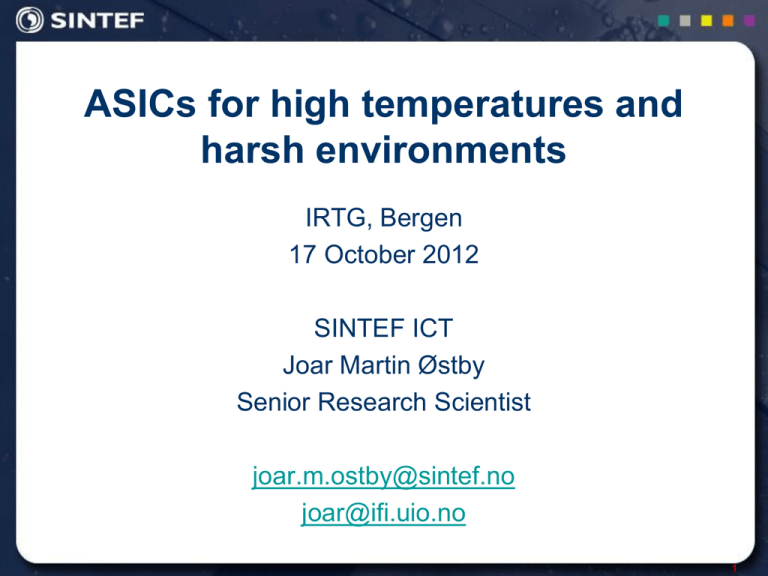
ASICs for high temperatures and harsh environments IRTG, Bergen 17 October 2012 SINTEF ICT Joar Martin Østby Senior Research Scientist joar.m.ostby@sintef.no joar@ifi.uio.no 1 Outline 1. Definitions 2. ICs in general 3. High temperature in general a) Market b) Challenges c) Substrate, connectivity and integration d) Semiconductor technologies e) Integrated circuits (ASICs) Discrete components: sensors and devices g) Standard components f) 4. Activity at SINTEF a) ASICs b) Harsh environment projects 2 1. Definitions Temperature range Standard/commercial temperature range: 0°C-70°C Industrial: 0°C-85°C Military temperature range: -40°C-125°C High temperature (HT): > 125°C Very high temperature > 250°C Low temperature (LT) < -40°C Very low temperature < -150°C Extremely low temperature < 40°K HTE: High Temperature Electronics 3 Electronic operational range Total reported temperature range: -270°C - 700°C Lower end (-270°C): Si, Ge, GaAs Higher end (700°C): Diamond Schottky Diode, SiC MOSFET (650°C), Si and GaAs ICs (400-500°C). Operational range of same component: -270°C to 400°C 4 What are the benefits of ICs? Small size Less parts Simple logistics Low weight Higher frequencies/clock rates Increased reliability Easier to protect in harsh environments Low power consumption (energy consumption and heat) Less noise sensitivity to most types of noise Less noise emission Lower price in medium and higher volumes Improved performance/price ratio Better hiding of design solutions Better total system performance Increased flexibility (some functions can only be implemented in ASICs) 5 2. High temperature in general 6 2.a Market 7 Market is increasing but will continue to be a niche market Large majority of HT applications in the range 125°C200°C Main customers: Automotive Avionics/Space Oil & Gas 8 Market - Avionics 9 Market - Avionics 10 Market - Automotive 11 Automotive – HT electronics requirements 12 Market - Petroleum 13 Oil & Gas – Operating conditions Well depths: Oil and gas: 3-6 km Geothermal: 10km Temperature range: Majority of oil wells are under 125°C with 80% < 150°C Only 2-3% are > 200°C Geothermal wells: 25°C to 400°C with most wells covered by 325°C 14 Requirements for in-well systems Passive and active electronics Reliability is # 1 (more important than cost) Application areas Permanent in-well monitoring <200°C with years of continuous operation Well logging systems (wireline operation) <220°C with operation for some few days Drilling <220°C with operation for 2-3 months Geothermal and steam assisted wells > 300°C operation and years of operation 15 Oil & Gas – Environment conditions High temperature Low temperature Thermal cycling Moisture Hermeticity Residual stresses Vibration Shock Thermo mechanical effects Ionising radiation Aggressive chemical environments 16 Metallization - Reliability 18 HT influence on silicon devices Physical temperature dependencies … Fermi level Intrinsic carrier density Carrier generation rate Carrier mobility … is resulting in a change of … Conductance Transconductance Leakage current Diode voltage drop FET threshold voltage 19 HT influence on silicon devices Reliability Electro migration of conductors increases Chemical reactivity increases Diffusion of dopants and ohmic contacts increases Dielectric breakdown strength decreases Mechanical stresses increases Latch-up 20 High Temperature Semiconductors 21 High Temperature Semiconductors 22 Semiconductors Electrical properties of relevant semiconductors Property Bandgap (eV) Si GaAs 4H-SiC GaN AlN 1.12 1.43 3.26 3.4 6.1 Breakdown field (V/µm) 30 30 250 250 1200 Thermal conductivity (W/cm °K) 1.5 0.5 4.5 1.5 3.3 Saturated Velocity (cm/s) 1E7 1E7 2E7 1.5E2.7E7 1.8E7 Electron mobility (cm2/V s)@2E17 cm-3 600 4000 400 1000-2000 Hole mobility (cm2/V s) 150 30 Small Die with High Pad Count and/or High Power Density – Improved current density capabilities and higher operating temperature 23 X-FAB XI10 SOI-process Core NMOS, PMOS, R and C 3 metal layers 90V drain-source voltage 5V gain-source Optional Metal Al 175°C Tungsten 225°C 1µm oxide layer 650µm handle wafer High res poly Cap (90V) 0.13fF/µm² (1cm² ~ 13nF) Reduced Cpara reduced Pdyn Reduced Ileak reduced Pstat 24 Bulk and SOI cost examples XFAB CMOS: Bulk (0.6umBiCMOS) and SOI (1.0umCMOS) cost 60000 50000 EUR Bulk MPW 5 dices 40000 Bulk MLM 6 wafers 30000 Bulk FMS 6 wafers SOI MPW 5 dices 20000 SOI MLM 6 wafers SOI FMS 6 wafers 10000 0 0 20 40 60 80 100 Chip size in mm2 25 HT IC manufacturers Technology Manufacturer Max op. temp Product CMOS AMD 175°C LSI standard CMOS TI 200°C LSI standard CMOS SOI Honeywell 175°C/225°C IC processhouse, LSI standard, ASIC CMOS SOI X-Fab 175°C/225°C IC processhouse (X-Fab) CISSOID 175°C/225°C SSI/MSI standard (AMS/X-Fab/…) SINTEF 175°C/225°C LSI ASIC SiC TranSic CREE Infineon 300°C Discrete SiC Raytheon, UK 300/400°C SSI 26 HT (200°C) and HV (600-800V) devices UnitedSic 4H-SiC BJT(150°C, 600V), VJFET (200°C, 1200V) and Shottky Diode (700V) TranSIC (225°C 800V) SiC BJT, Si IGBT BitCsic SiC NPN power (250°, 1200V) 28 TX530: DSP, ADC’s, DAC’s, Dig I/O -50°C to +200°C 16-bit TMS320F240 DSP core 16kw flash & 32kw SRAM Inte. RC osc 2.304MHz±1% 8 10-bit ADCs, 10µs 3 10-bit DACs PWM outputs Applications Petroleum Aircraft Smart sensor applications 30 3. Activity at SINTEF 31 µPEK activity Interconnects Wire bonding, die-attach, micro bumps (3D stacking) Components Thick and thin film resistors Ceramic capacitors Microcontroller Diode laser Optical transmitter and receiver 32 µPEK: ATMega88 Microcontroller The Atmel ATmega88 selected because: Popular, modern 8-bit architecture. Low power consumption. Automotive version available, specified to +125°C (+150°C). A lot of different variants, made in the same process. Internal EEPROM and selfprogrammable FLASH. Wide operating voltage range, 2.7 – 5.5V @ -55 – +125 (+150)°C. 33 µPEK: Results ATMega 88 Operation limit around 180C. Latch-up observed at 185C One component have survived 8 months operation at 180C without any signs of degradation. Further testing of a number of components in parallel is required. 34 µPEK: 7 years operation at 200C. Is it feasible? Substrate metallization Resistors Wire bonding Capacitors ?? Die attach Use small capacitance values Derating is highly important! Use Class I (NP0) capacitors Integrated circuits 35 Centrifugal Level Gauge Gamma Multiphase Flowmeter High Temperature Instrumentation for Oil Production Environmental characteristics: Casing Strain Logging-free Wells (LFW) Temperatures: 0 - 200 ºC Pressure: 0 - 1000 bar Vibration, shock Aggressive liquids/gases Difficult/expensive to test Advanced Production Logging (APL) 36 High Temperature (~200°C) at SINTEF TOPSIDE UNIT Started 1984, design of logging tool Characterisation of CMOS/BICMOS technology for HT in 1988 First ASIC in 1992. Complex mixed signal circuit working up to 275°C Almost all work related to tools for the petroleum sector Power Data transfer card Rx/Tx 4km 1/4" downhole cable 13W/km,100nF/km DOWNHOLE CONTROL MODULE Communication unit TMM TTC Sensor#1 ELS-001 TTC Sensors #2 - #6 P T HTPOWER HTPOWER single conductor local bus inside tool string Up to 6 control modules may be connected in series Signal and power bus (2 x 1/8" downhole cable) 37 Library of high temperature ASICs TMM Telemetry Master Module (long distance biphase telemetry Tx/Rx, system sync) TOPSIDE UNIT TTC Telemetry Tool Chip Power (time multiplexing, directly connected to single wire bus) Data transfer card Rx/Tx HTP High Temperature Power (serial regulator with built in reference voltage) ELS Quartz oscillator control chip 4km 1/4" downhole cable 13W/km,100nF/km (four channel oscillator/mixer for quartz sensor interface) CMC Capacitance Measurement Circuit (capacitance measurement, pF-nF, S/D <1%, high res.) A/D converter based on sigma-delta principle (A/D-converter diff. input +-1V, DOWNHOLE CONTROL MODULE Communication unit TMM TTC < 0.1%, low noise) The chips are designed for use at temperatures up to 200°C. They may either be put together as a complete system for remote measurements or be used separately. ELS-001 TTC VFC Voltage to frequency converter SAC Spectrum Analyser Chip (not yet fully verified) (spectrum analyzer chip 500Hz-50kHz) Sensor#1 Sensors #2 - #6 P T HTPOWER HTPOWER single conductor local bus inside tool string Up to 6 control modules may be connected in series Signal and power bus (2 x 1/8" downhole cable) 38 NCM-eye Goal: Measure resistance in rock Two ASICs designed for 200°C operation temperature Measurement setup: 100-200V AC is set up over the rock region to be inspected Sensor front ends width very high input impedance (10-100GW) measure the local voltage level Voltage differences between neighbour pairs are found Resulting values are converted into a digital format and feed into common buses 39 AHZFE 40 ADAQ4 41 PharusIT Phased Array Ultrasonic Transducers for Inspection of Tubing EU project partners: SINTEF (Norway), Schlumberger Ribound Product Center (France), Schlumberger - Doll Research (USA), CSIC (Spain), IMASONIC (France), TRONICO (France), STATICE (France) and BAM (Germany). The primary objective of this ultrasonic imaging system was to perform non destructive testing in fluid filled oil wells. Typical specifications are 1400 bar and 175°C in harsh environments. A variety of tasks are performed by the same system. E.g. locate rock fractures in the borehole wall or assess the quality of the cement placed in the annular space between cased steel pipe and rock wall. The system architecture consists of a 2-D transducer array of 800 elements, a transmitter block, integrated front end receiver electronics, and FPGA circuits for controlling the array elements and performing the digital beam forming. Publications and presentations: HITEN 2005 ESSCIRC 2005 IEEE International Ultrasonic Symposium 2005. IEEE Journal of Solid-State Circuits 2006 42 PharusIT (BatASIC) NA _L TP OU V COND G _P NP VI GA _P A TP OU V DA _O DA _O NP VI TP OU IT LIM V D _S S D FH SY _S RE K_ NP V I CL V A _A D _D D_ D D_ D M VD GN VD GN V_ Resistor RFB_LNA Clock Timing Global PGA Output Buffer VINN_LNA LNA 12dB 20dB 0dB 6dB 12dB 18dB Buffers ODA 0dB 10dB Buffers Amplitude Limiter Sigma Delta Modulator (Second Order) Buffers VOUT_SD VINP_LNA Current Mirrors Gain Decoder A LN N_ UT O V G _P NN VI A G0 G1 G2 G3 BATASIC Ultrasound Signal Processor Current Reference A PG N_ UT O V DA _O NN VI DA _O TN U O N PD V D _S D FL _S RE NN V I V 43 High-temperature CMOS services The library of complex circuits We have today a library of working circuits that we sell. Several of them have a rather general behaviour and could be used in different systems. These are rather complex circuits containing several thousand transistor equivalents each. New ASICs We sell our high temperature design competence and design new circuits according to specifications by the customer. Simple standard cells We may design and sell simpler "standard" cells. This may be a possibility for one customer or for several customers cooperating for the same specification. Possible circuits may be amplifiers, switches, memories etc. Synthesized layout from customer input We may generate digital layouts with our high temperature digital library from specifications given by the customer. The specification may be in some kind of high level language. Examples here are micro controllers delivered by the customers or from our contacts. 44 SINTEF ICT, Dept. for Instrumentation Main focus is Instrumentation for demanding environments Enabling technologies Micro-, opto- and nano-technologies are used to develop innovative integrated products and sensor systems in close collaboration with Industrial partners Start-up and venture companies Applications areas 80 Measured Estimate 60 offshore, subsea, oil- and gas wells process industry automotive Health related ICT 40 20 0 100 200 300 30 400 500 600 700 600 700 600 700 Measured Estimate 20 10 0 100 200 30 300 400 500 Measured Estimate 20 10 0 100 200 300 400 500 Different measurements Lean technology approach 45 Centrifugal Separator Level Gauge (2000) 3600 rpm Capacitive level detection: - 0.1mm water/oil, - 0.3mm gas/oil Non-contact signal transmission Built-in power generation Operation at 0-100 ºC, 3600 g acceleration Operated successfully for >2 years 46 SLG (Separator Level Gauge) Measure pressure at several vertically separated points in the separator tank and combining the results mathematically to extract the water/oil/gas levels. Measuring these small levels of change in pressure (<100pa) is achieved by using differential pressure sensors arranged in an vertical array. The instrument has been tested for line pressure up to 196 bar and temperature up to 125°C Celsius. Patented by Statoil Pressure certified by DNV (Det Norske Veritas Certification AS) EX certified by Nemko Planned to be installed at Oseberg 47 Noise Recording tool (Acoustic logging tool) Main specifications Well pressure 750 bar Well temperature 175ºC Frequency range 1 to 500Hz (fs = 1000 Hz) Automatic gain 100, 120, 140,160 dB ref 20µPa max Measurement resolution 8 bits ( 0.5%FS) Memory capacity: 16 series of 64 (32) sec each Power consumption < 20mA @ 5V Signal read out Via wireline contact to PC Length of tool Double pickup: 1,7m, single; 1,04m Sensor element (patent pending) FFT Plot 48 Ongoing and future projects Wireless in-well communication systems (semi-permanent – commercial phase) In-well acoustic noise recording tool (wireline – commercial phase) High reliability in-well instrumentation platform for the future (SINTEF strategic project - research) Pipeline monitoring for integrity and corrosion control (permanent – subsea pilot phase) In-well timer and release with very high accuracy (Research and test phase – permanent) ++ 49



